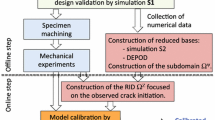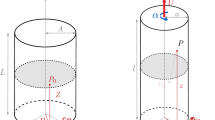Abstract
This work studies how a nonlinear kinematic model aimed for cyclic plasticity could be put into effect and used within a FEM code. A correct modeling of cyclic elasto-plastic behavior can be exploited in low-cycle fatigue life investigation as well as in manufacturing problems related to springback prediction. The chosen formulation has been proposed by Chaboche, and it is implemented in most of the commercial codes used for nonlinear FEM simulations. At first, a procedure for the proper identification of unknown material model parameters has been put forward. This calibration, based on the data collected from experimental low-cycle fatigue tests, has been performed by means of an inverse method. Laboratory tests differ according to the type of material under investigation. A classification can be operated distinguishing between specimens obtained from bulk materials or from sheet metals. For the former, standard tension-compression tests have been performed, while for the latter, a dedicated testing equipment for three-point bend cyclic tests has been devised. Then, further experimental tests have been run to check model transferability: different strain per cycle amplitudes, asymmetric strain cycling and different stress triaxiality levels have been investigated. For each of these tests, experimental vs. FEM results have been analyzed to show the level of agreement that has been reached.
Similar content being viewed by others
References
Khan AS, Huang S (1995) Continuum theory of plasticity. Wiley, New York
McClintock FA, Argon AS (1966) Mechanical behavior of materials. Addison-Wesley, Reading
Li KP, Carden WP, Wagoner RH (2002) Simulation of springback. Int J Mech Sci 44:103–122
Zhao KM, Lee JK (2002) Finite element analysis of three-point bending test for sheet metal. J Mater Process Technol 122:6–11
Ling Y (1996) Uniaxial true stress-strain after necking. AMP J Technol 5:37–48
Snyman JA (2005) Practical mathematical optimisation. Springer, New York
Press H, Teukolsky SA, Vetterling T, Flannery P (2002) Numerical recipes in C, the art of scientific computing, 2nd edn. Cambridge University Press, Cambridge
Armstrong PJ, Frederick CO (1966) A mathematical representation of the multiaxial Bauschinger effect. CEGB Report, RD/B/N731, Berkeley Nuclear Laboratories
Chaboche JL (1986) Time-independent constitutive theories for cyclic plasticity. Int J Plast 2:249
Chaboche JL (1989) Constitutive equations for cyclic plasticity and cyclic viscoplasticity. Int J Plast 5:247
Campana F, Cortese L, Placidi F (2006) Finite element analysis of high strength steel stamping process adopting a combined isotropic-kinematic hardening model: experimental investigation of the improvements achieved in springback prevision. In: IDDRG 06, international deep drawing research group, proceedings of the 2006 conference, Porto, Portugal, 19–21 June 2006
Author information
Authors and Affiliations
Corresponding author
Rights and permissions
About this article
Cite this article
Broggiato, G.B., Campana, F. & Cortese, L. The Chaboche nonlinear kinematic hardening model: calibration methodology and validation. Meccanica 43, 115–124 (2008). https://doi.org/10.1007/s11012-008-9115-9
Accepted:
Published:
Issue Date:
DOI: https://doi.org/10.1007/s11012-008-9115-9




